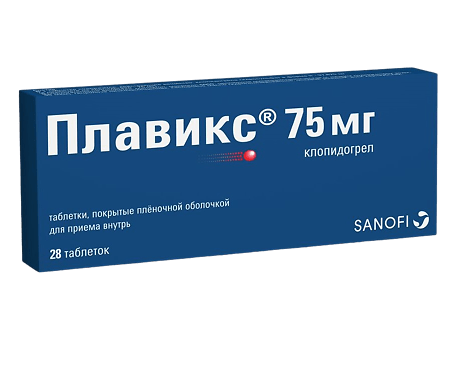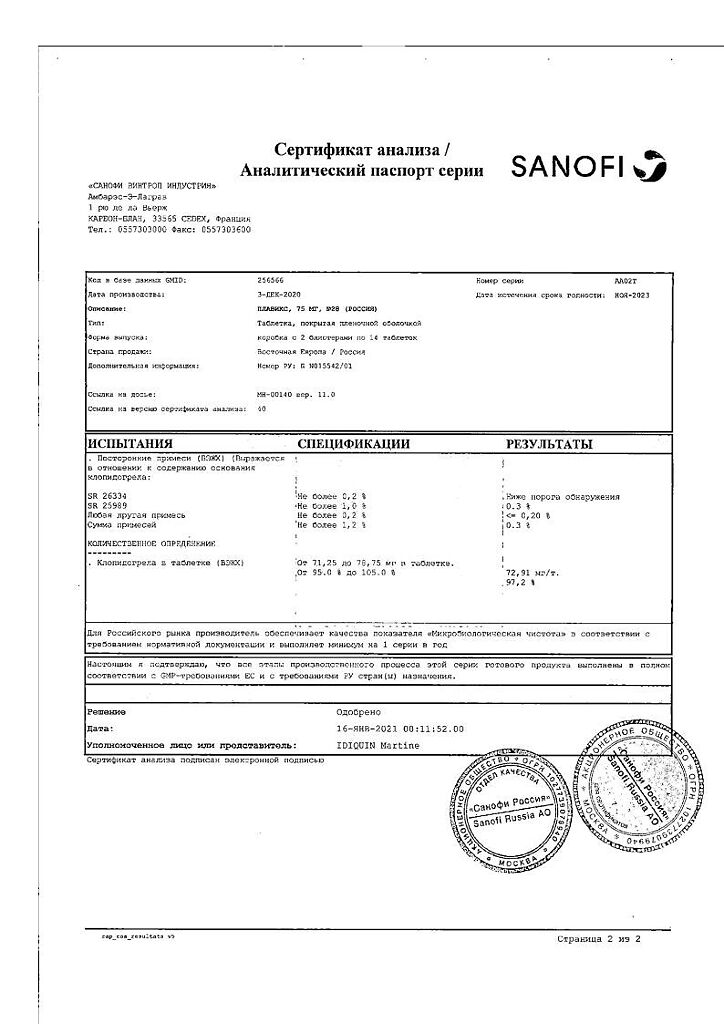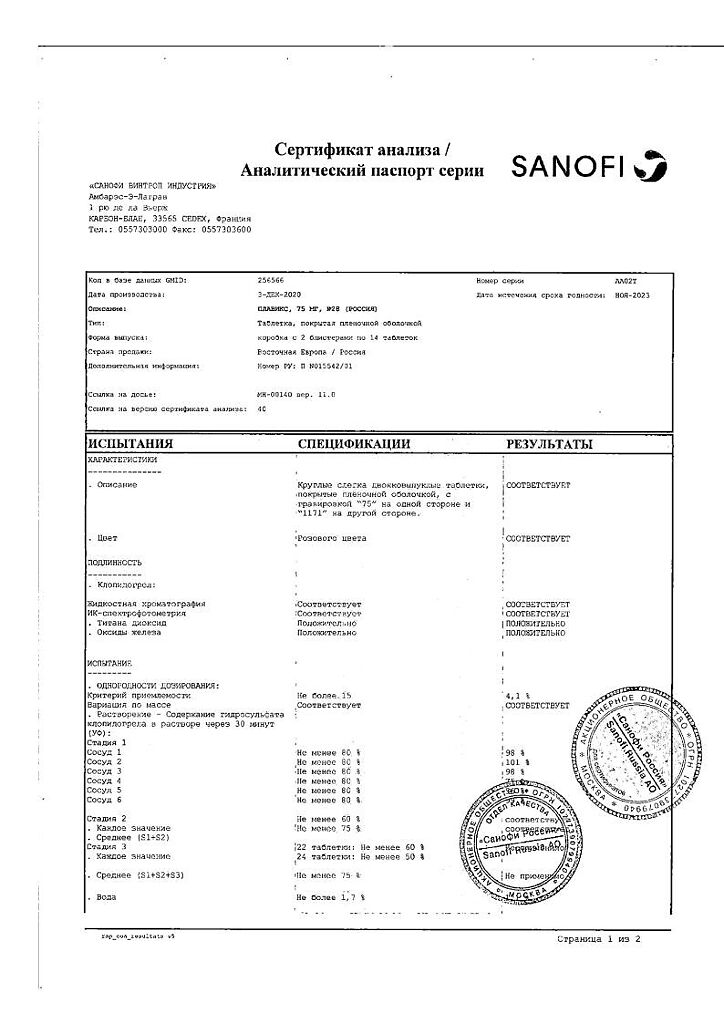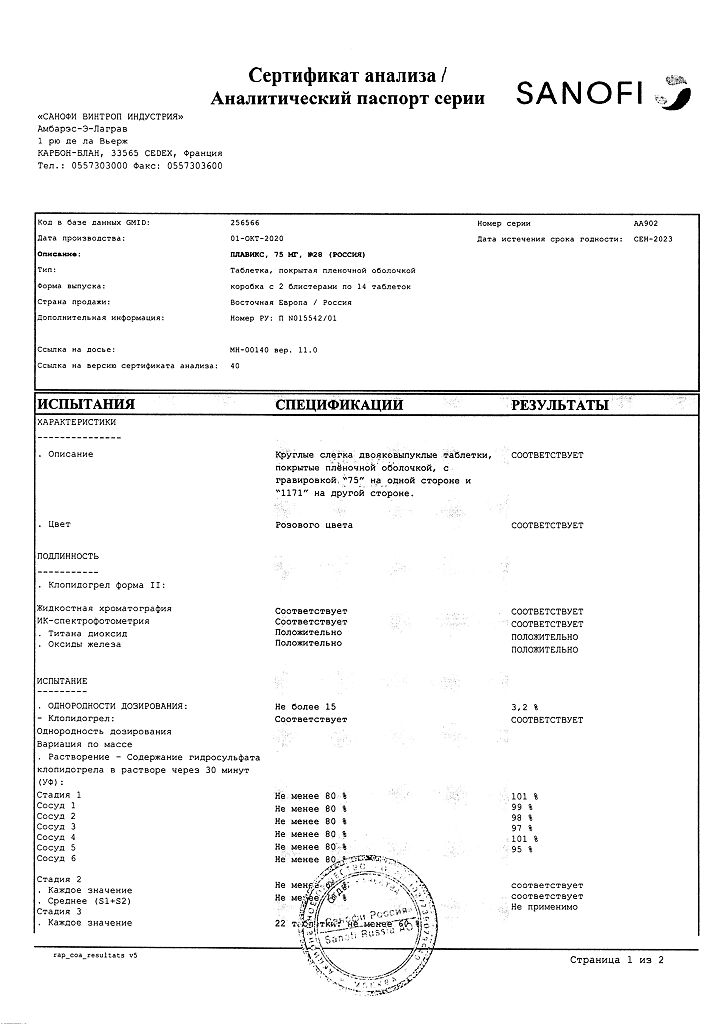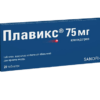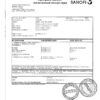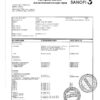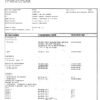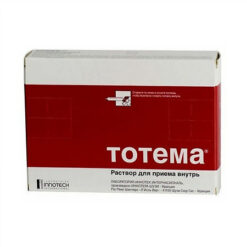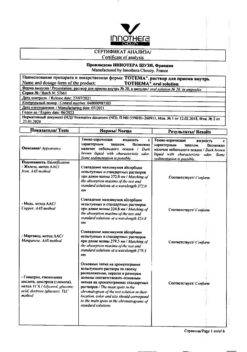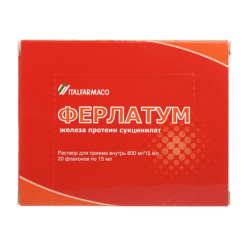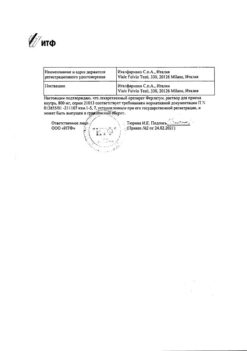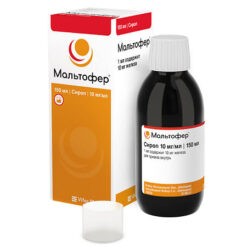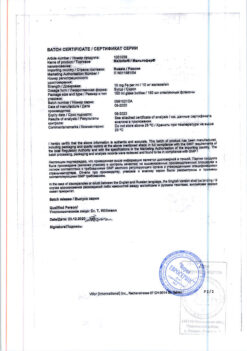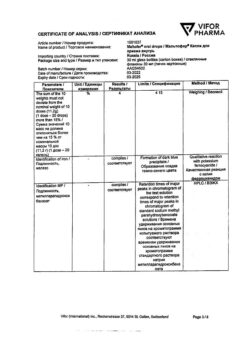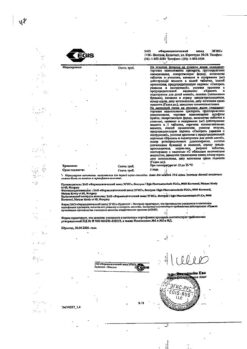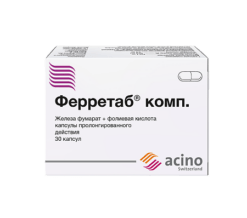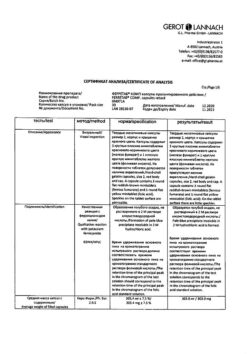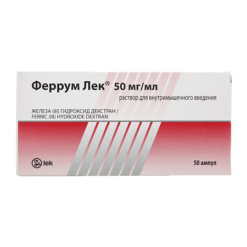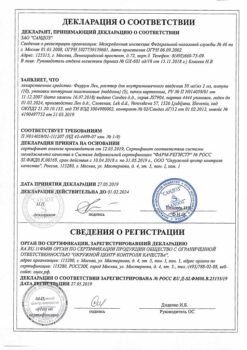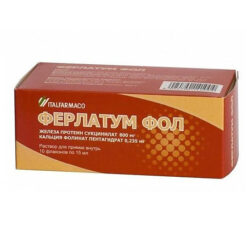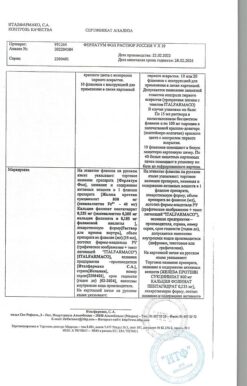No products in the cart.
Plavix, 75 mg 28 pcs.
€24.28 €20.23
Description
Plavix is an antiaggregative.
Pharmacodynamics
Clopidogrel is a prodrug, one of the active metabolites of which is an inhibitor of platelet aggregation. The active metabolite of clopidogrel selectively inhibits the binding of ADP to the P2Y12-receptor of platelets and the subsequent ADP-mediated activation of the GPIIb/IIIa complex, leading to suppression of platelet aggregation. Through irreversible binding, platelets remain immune to ADP stimulation for the remainder of their lives (approximately 7-10 days), and recovery of normal platelet function occurs at a rate consistent with the rate of platelet renewal.
The aggregation of platelets caused by agonists other than ADP is also inhibited by blocking enhanced platelet activation by the released ADP.
Since the formation of the active metabolite occurs via enzymes of the P450 system, some of which may be polymorphic or inhibited by other drugs, not all patients may have adequate inhibition of platelet aggregation.
When clopidogrel is taken daily at a dose of 75 mg, significant suppression of ADP-induced platelet aggregation is noted from the first day of administration, which gradually increases over 3-7 days and then reaches a constant level (when an equilibrium state is reached). In the equilibrium state, platelet aggregation is suppressed by an average of 40-60%. After stopping clopidogrel administration, platelet aggregation and bleeding time gradually return to the initial level, on average within 5 days.
Clopidogrel is able to prevent the development of atherothrombosis in any localization of atherosclerotic vascular lesions, particularly in lesions of the cerebral, coronary or peripheral arteries.
. The ACTIVE-A clinical trial showed that patients with atrial fibrillation who had at least one risk factor for vascular complications but were unable to take indirect anticoagulants, clopidogrel combined with acetylsalicylic acid (ASA) (compared with taking ASA alone) reduced the incidence of combined stroke, myocardial infarction, systemic thromboembolism outside the CNS vessels, or vascular death, more by reducing the risk of stroke.
The efficacy of clopidogrel in combination with acetylsalicylic acid was detected early and persisted for up to 5 years. The reduction in the risk of major vascular complications in the group of patients who took clopidogrel in combination with acetylsalicylic acid was mainly due to a greater reduction in the incidence of strokes. The risk of stroke of any severity when receiving clopidogrel in combination with ASA decreased, and there was a tendency to a lower incidence of myocardial infarction in the group treated with clopidogrel in combination with ASA, but there were no differences in the frequency of non-CNS vascular thromboembolism or vascular death. In addition, receiving clopidogrel in combination with ASA reduced the total number of days of hospitalization for cardiovascular causes.
Pharmacokinetics
Intake. Clopidogrel is rapidly absorbed at a single and repeated oral dose of 75 mg/day.
The mean peak plasma concentrations of unchanged clopidogrel (approximately 2.2-2.5 ng/ml after oral administration of a single dose of 75 mg) are reached approximately 45 min after administration. According to the urinary excretion of clopidogrel metabolites, its absorption is approximately 50%.
Distribution. In vitro, clopidogrel and its main circulating inactive metabolite are reversibly bound to plasma proteins (by 98% and 94%, respectively), and this binding is unsaturated over a wide range of concentrations.
Metabolism. Clopidogrel is extensively metabolized in the liver. In vitro and in vivo clopidogrel is metabolized in two ways: the first – through esterases and subsequent hydrolysis to form an inactive metabolite, carboxylic acid derivative (85% of circulating metabolites), and the second way – through the cytochrome P450 system. First, clopidogrel is metabolized to 2-oxo-clopidogrel, which is an intermediate metabolite. Subsequent metabolism of 2-oxo-clopidogrel leads to the formation of the active metabolite of clopidogrel – thiol derivative of clopidogrel. In vitro, this metabolic pathway is metabolized by the P450 isoenzymes CYP2C19, CYP1A2, and CYP2B6. The active thiol metabolite of clopidogrel, which has been isolated in in vitro studies, binds rapidly and irreversibly to platelet receptors, blocking platelet aggregation.
Elimination. Within 120 hours after human oral administration of 14C-labeled clopidogrel about 50% of radioactivity is excreted in the urine and approximately 46% of radioactivity is excreted in the feces. After a single oral dose of 75 mg, the T1/2 of clopidogrel is approximately 6 hours. After a single dose and repeated doses, the T1/2 of the main circulating inactive metabolite in blood is 8 hours.
Pharmacogenetics. Both the active metabolite and the intermediate metabolite 2-oxo-clopidogrel are formed using CYP2C19 isoenzyme. The pharmacokinetics and antiaggregant effects of the active metabolite clopidogrel, in an ex vivo study of platelet aggregation, vary depending on the genotype of the CYP2C19 isoenzyme.
The CYP2C19*1 gene allele corresponds to fully functional metabolism, whereas the CYP2C19*2 and CYP2C19*3 gene alleles are nonfunctional. The CYP2C19*2 and CYP2C19*3 gene alleles are responsible for reduced metabolism in the majority of Caucasoid (85%) and Mongoloid races (99%). Other alleles that are associated with absence or reduced metabolism are less common and include, but are not limited to, CYP2C19*4, *5, *6, *7, and *8 alleles. Patients with low CYP2C19 isoenzyme activity must have the two loss-of-function gene alleles listed above.
The published incidence of phenotypes of individuals with low CYP2C19 isoenzyme activity is 2% in Caucasians, 4% in non-Hispanics, and 14% in Chinese.
Tests are available to determine if a patient has the CYP2C19 isoenzyme genotype. According to a cross-sectional study (40 healthy volunteers) and a meta-analysis of six studies (335 healthy volunteers) taking clopidogrel that included healthy volunteers with very high, high, intermediate and low CYP2C19 isoenzyme activity, no significant differences in the exposure of the active metabolite and in the mean values of platelet aggregation inhibition (IAT) (induced ADP) in healthy volunteers with very high, high, and intermediate CYP2C19 isoenzyme activity were found. In healthy volunteers with low CYP2C19 isoenzyme activity, exposure to the active metabolite was decreased compared to healthy volunteers with high CYP2C19 isoenzyme activity.
When healthy volunteers with low CYP2C19 isoenzyme activity received the 600 mg – loading dose/150 mg – maintenance dose (600/150 mg) treatment regimen, exposure of the active metabolite was higher than when receiving the 300/75 mg treatment regimen. In addition, IAT was similar to that in groups of healthy volunteers receiving clopidogrel, with higher metabolism by the CYP2C19 isoenzyme receiving the 300/75 mg treatment regimen. Dosing regimen of clopidogrel in low CYP2C19 isoenzyme activity.
Indications
Indications
Prevention of atherothrombotic complications:
adult patients with myocardial infarction (with a duration of several days to 35 days), ischemic stroke (with a duration of 7 days to 6 months) or with diagnosed peripheral arterial occlusive disease;
adult patients with acute coronary syndrome: without ST segment elevation (unstable angina or non-Q wave myocardial infarction), including patients who underwent stenting during percutaneous coronary intervention (in combination with ASA); with ST segment elevation (acute myocardial infarction) with drug treatment and the possibility of thrombolysis (in combination with ASA).
Prevention of atherothrombotic and thromboembolic complications, including stroke, in atrial fibrillation (atrial fibrillation).
Patients with atrial fibrillation (atrial fibrillation) who have at least one risk factor for the development of vascular complications cannot take indirect anticoagulants and have a low risk of bleeding (in combination with ASA).
Pharmacological effect
Pharmacological effect
Plavix – antiaggregation.
Pharmacodynamics
Clopidogrel is a prodrug, one of the active metabolites of which is an inhibitor of platelet aggregation. The active metabolite of clopidogrel selectively inhibits the binding of ADP to the platelet P2Y12 receptor and subsequent ADP-mediated activation of the GPIIb/IIIa complex, leading to suppression of platelet aggregation. Due to irreversible binding, platelets remain immune to ADP stimulation for the remainder of their life (approximately 7–10 days), and restoration of normal platelet function occurs at a rate consistent with platelet turnover.
Platelet aggregation induced by agonists other than ADP is also inhibited by blocking enhanced platelet activation by released ADP.
Since the formation of the active metabolite occurs with the help of enzymes of the P450 system, some of which may differ in polymorphism or are inhibited by other drugs, adequate inhibition of platelet aggregation is not possible in all patients.
When taking clopidogrel daily at a dose of 75 mg, from the first day of administration there is a significant suppression of ADP-induced platelet aggregation, which gradually increases over 3-7 days and then reaches a constant level (when an equilibrium state is reached). At steady state, platelet aggregation is suppressed by an average of 40–60%. After discontinuation of clopidogrel, platelet aggregation and bleeding time gradually returned to baseline levels, on average within 5 days.
Clopidogrel is able to prevent the development of atherothrombosis in any localization of atherosclerotic vascular lesions, in particular in lesions of the cerebral, coronary or peripheral arteries.
The ACTIVE-A clinical trial showed that in patients with atrial fibrillation who had at least one risk factor for vascular complications but were unable to take indirect anticoagulants, clopidogrel in combination with acetylsalicylic acid (ASA) (compared with ASA alone) reduced the incidence of stroke, myocardial infarction, and non-CNS systemic thromboembolism combined or vascular death, largely due to a reduced risk of stroke.
The effectiveness of taking clopidogrel in combination with acetylsalicylic acid was detected early and persisted for up to 5 years. The reduction in the risk of major vascular complications in the group of patients taking clopidogrel in combination with acetylsalicylic acid was mainly due to a greater reduction in the incidence of stroke. The risk of stroke of any severity was reduced when taking clopidogrel in combination with ASA, and there was a trend towards a decrease in the incidence of myocardial infarction in the group treated with clopidogrel in combination with ASA, but there were no differences in the incidence of non-CNS thromboembolism or vascular death. In addition, taking clopidogrel in combination with ASA reduced the total number of days of hospitalization for cardiovascular reasons.
Pharmacokinetics
Suction. With a single or repeated oral dose of 75 mg/day, clopidogrel is rapidly absorbed.
Average peak plasma concentrations of unchanged clopidogrel (approximately 2.2–2.5 ng/ml after oral administration of a single 75 mg dose) are achieved approximately 45 minutes after administration. Based on urinary excretion of clopidogrel metabolites, its absorption is approximately 50%.
Distribution. In vitro, clopidogrel and its main circulating inactive metabolite are reversibly bound to plasma proteins (98 and 94%, respectively), and this binding is unsaturated over a wide range of concentrations.
Metabolism. Clopidogrel is extensively metabolized in the liver. In vitro and in vivo, clopidogrel is metabolized in two ways: the first – through esterases and subsequent hydrolysis with the formation of an inactive metabolite, a carboxylic acid derivative (85% of circulating metabolites), and the second way – through the cytochrome P450 system. Initially, clopidogrel is metabolized to 2-oxo-clopidogrel, which is an intermediate metabolite. Subsequent metabolism of 2-oxo-clopidogrel leads to the formation of the active metabolite of clopidogrel, a thiol derivative of clopidogrel. In vitro, this metabolic pathway occurs via the P450 isoenzymes CYP2C19, CYP1A2 and CYP2B6. The active thiol metabolite of clopidogrel, which was isolated in in vitro studies, rapidly and irreversibly binds to platelet receptors, blocking platelet aggregation.
Excretion. Within 120 hours after human ingestion of 14C-labeled clopidogrel, about 50% of the radioactivity is excreted in the urine and approximately 46% of the radioactivity is excreted in the feces. After a single oral dose of 75 mg, T1/2 of clopidogrel is approximately 6 hours. After a single dose and repeated doses, T1/2 of the main inactive metabolite circulating in the blood is 8 hours.
Pharmacogenetics. With the help of the CYP2C19 isoenzyme, both the active metabolite and the intermediate metabolite, 2-oxo-clopidogrel, are formed. The pharmacokinetics and antiplatelet effect of the active metabolite of clopidogrel, when studying platelet aggregation ex vivo, vary depending on the genotype of the CYP2C19 isoenzyme.
The allele of the CYP2C19*1 gene corresponds to a fully functional metabolism, while the alleles of the CYP2C19*2 and CYP2C19*3 genes are non-functional. Alleles of the CYP2C19*2 and CYP2C19*3 genes are the cause of decreased metabolism in the majority of representatives of the Caucasian (85%) and Mongoloid races (99%). Other alleles associated with absent or decreased metabolism are less common and include, but are not limited to, the CYP2C19*4, *5, *6, *7, and *8 alleles. Patients with low CYP2C19 isoenzyme activity must have the two loss-of-function gene alleles listed above.
The published frequencies of occurrence of phenotypes in individuals with low activity of the CYP2C19 isoenzyme are 2% in Caucasians, 4% in Blacks, and 14% in Chinese.
To determine the patient’s genotype of the CYP2C19 isoenzyme, there are appropriate tests. In a crossover study (40 healthy volunteers) and a meta-analysis of six studies (335 healthy volunteers) treated with clopidogrel, which included healthy volunteers with very high, high, intermediate and low CYP2C19 isoenzyme activity, there were no significant differences in the exposure of the active metabolite and in the mean values of inhibition of platelet aggregation (IAT) (induced by ADP) in healthy volunteers with very high, high and low activity. No intermediate activity of the CYP2C19 isoenzyme was detected. In healthy volunteers with low activity of the CYP2C19 isoenzyme, exposure to the active metabolite was reduced compared to healthy volunteers with high activity of the CYP2C19 isoenzyme.
When healthy volunteers with low CYP2C19 activity received a 600 mg loading dose/150 mg maintenance dose regimen (600/150 mg), exposure to the active metabolite was higher than when taking a 300/75 mg treatment regimen. In addition, the IAT was similar to that in the groups of healthy volunteers receiving clopidogrel, with a higher rate of metabolism by the isoenzyme CYP2C19 receiving the 300/75 mg treatment regimen. Clopidogrel dosage regimen for low activity of the CYP2C19 isoenzyme.
Special instructions
Special instructions
When treating with clopidogrel, especially during the first weeks of treatment and/or after invasive cardiac procedures/surgery, patients must be carefully monitored to exclude signs of bleeding, incl. hidden.
Due to the risk of bleeding and hematological undesirable effects (see “Side effects”), if clinical symptoms suspicious for bleeding appear during treatment, you should urgently do a clinical blood test, determine the APTT, platelet count, indicators of platelet functional activity and conduct other necessary studies.
Clopidogrel, like other antiplatelet drugs, should be used with caution in patients with an increased risk of bleeding associated with trauma, surgery or other pathological conditions, as well as in patients receiving ASA, other NSAIDs, incl. COX-2 inhibitors, heparin or glycoprotein IIb/IIIa inhibitors.
The combined use of clopidogrel with warfarin may increase the intensity of bleeding (see “Interactions”), so caution should be exercised when using clopidogrel and warfarin together.
If the patient is undergoing elective surgery, and there is no need for an antiplatelet effect, then clopidogrel should be discontinued 5–7 days before surgery.
Clopidogrel prolongs bleeding time and should be used with caution in patients with diseases predisposing to the development of bleeding (especially gastrointestinal and intraocular). Drugs that can cause damage to the gastrointestinal mucosa (NSAIDs, including ASA) in patients taking clopidogrel should be used with caution.
Patients should be warned that when taking clopidogrel (alone or in combination with ASA), it may take longer to stop bleeding, and that if they experience unusual bleeding (in location or duration) they should inform their doctor. Before any upcoming surgery and before starting any new drug, patients should tell their doctor (including their dentist) that they are taking clopidogrel.
Very rarely, after the use of clopidogrel (sometimes even for a short period), cases of the development of TTP, which is characterized by thrombocytopenia and microangiopathic hemolytic anemia, accompanied by neurological disorders, renal dysfunction and fever, have been reported. TTP is a potentially life-threatening condition that requires immediate treatment, including plasmapheresis.
It has been shown that in patients with a recent history of transient cerebrovascular accident or stroke who are at high risk of developing recurrent ischemic complications, the combination of ASA and clopidogrel increases the risk of major bleeding. Therefore, such combination therapy should be carried out with caution and only if there is clinical evidence of benefit from its use.
Cases of acquired hemophilia have been reported when taking clopidogrel. With a confirmed isolated increase in aPTT, accompanied or not accompanied by the development of bleeding, the possibility of developing acquired hemophilia should be considered. Patients with a confirmed diagnosis of acquired hemophilia should be observed and treated by specialists in this disease and stop taking clopidogrel.
Patients should be asked about a history of allergy to thienopyridines (such as ticlopidine, prasugrel), because Cross-allergy has been reported between thienopyridines and clopidogrel.
During the treatment period, it is necessary to monitor the functional state of the liver. In case of severe liver damage, one should remember the risk of developing hemorrhagic diathesis. Taking clopidogrel is not recommended for acute stroke less than 7 days old (as there is no data on its use in this condition).
Impact on the ability to drive a car and operate machinery. Plavix® does not significantly affect the abilities required to drive a car or operate machinery.
Active ingredient
Active ingredient
Clopidogrel
Composition
Composition
Active ingredient:
clopidogrel hydrosulfate in form II97.875 mg (in terms of clopidogrel – 75 mg);
Excipients:
mannitol – 68.925 mg;
macrogol 6000 – 34 mg;
MCC (low water content – 90 microns) – 31 mg;
low-substituted hyprolose – 12.9 mg;
hydrogenated castor oil – 3.3 mg;
Film casing:
Opadry pink (lactose monohydrate, hypromellose, titanium dioxide (E171), triacetin, red iron oxide dye (E172) – 7.5 mg; carnauba wax – traces
Contraindications
Contraindications
hypersensitivity to clopidogrel or any of the excipients of the drug;
severe liver failure;
acute bleeding, such as bleeding from a peptic ulcer or intracranial hemorrhage;
rare hereditary lactose intolerance, lactase deficiency and glucose-galactose malabsorption;
pregnancy and lactation (see “Use during pregnancy and lactation”);
children under 18 years of age (safety and effectiveness of use have not been established).
Use caution in the following conditions: moderate liver failure, which may predispose to bleeding (limited clinical experience); renal failure (limited clinical experience); injuries, surgical interventions (see “Special instructions”); diseases in which there is a predisposition to the development of bleeding (especially gastrointestinal or intraocular); simultaneous use of NSAIDs, incl. and selective COX-2 inhibitors; simultaneous administration of warfarin, heparin, glycoprotein IIb/IIIa inhibitors; patients with a genetically determined decrease in the function of the CYP2C19 isoenzyme (there is literature data indicating that patients with a genetically determined decrease in the function of the CYP2C19 isoenzyme are exposed to less systemic exposure to the active metabolite of clopidogrel and have a less pronounced antiplatelet effect of the drug, in addition, they may experience a higher incidence of cardiovascular complications after myocardial infarction compared with patients with normal function isoenzyme CYP2C19); a history of indications of allergic reactions to thienopyridines (for example, ticlopidine, prasugrel – the possibility of cross-allergy); recent transient cerebrovascular accident or acute ischemic stroke
Side Effects
Side Effects
From the nervous system: infrequently – headache, dizziness, paresthesia; rarely – vertigo.
From the gastrointestinal tract: often – dyspepsia, abdominal pain, diarrhea; uncommon – nausea, gastritis, bloating, constipation, vomiting, stomach ulcer, duodenal ulcer.
From the skin and subcutaneous tissue: uncommon – rash, itching.
From the blood and lymphatic system: uncommon – increased bleeding time, decreased platelet count in peripheral blood, leukopenia, decreased number of neutrophils in peripheral blood, eosinophilia.
Post-marketing experience with the drug
From the blood and lymphatic system: unknown frequency – cases of serious bleeding, mainly subcutaneous, musculoskeletal, ocular hemorrhages (conjunctival, tissue and retinal), bleeding from the respiratory tract (hemoptysis, pulmonary hemorrhage), nosebleeds, hematuria and bleeding from postoperative wounds and cases of fatal bleeding (especially intracranial hemorrhage, gastrointestinal bleeding and retroperitoneal hemorrhage), agranulocytosis, granulocytopenia, aplastic anemia/pancytopenia, thrombotic thrombocytopenic purpura (TTP), acquired hemophilia A.
From the immune system: unknown frequency – anaphylactoid reactions, serum sickness, cross-allergy with other thienopyridines (such as ticlopidine, prasugrel – see “Special Instructions”).
Mental disorders: unknown frequency – confusion, hallucinations.
From the nervous system: unknown frequency – disturbances in taste perception.
From the side of blood vessels: unknown frequency – vasculitis, decreased blood pressure.
From the respiratory system, chest and mediastinal organs: unknown frequency – bronchospasm, interstitial pneumonia, eosinophilic pneumonia.
From the gastrointestinal tract: unknown frequency – colitis (including ulcerative or lymphocytic), pancreatitis, stomatitis.
From the liver and biliary tract: unknown frequency – hepatitis (non-infectious), acute liver failure.
From the skin and subcutaneous tissues: unknown frequency – maculopapular erythematous or exfoliative rash, urticaria, pruritus, angioedema, bullous dermatitis (erythema multiforme, Stevens-Johnson syndrome, toxic epidermal necrolysis), drug hypersensitivity syndrome, drug rash with eosinophilia and systemic manifestations (DRESS syndrome), eczema, lichen planus.
Musculoskeletal and connective tissue disorders: unknown frequency – arthralgia (joint pain), arthritis, myalgia.
From the kidneys and urinary tract: unknown frequency – glomerulopathy (including glomerulonephritis).
General disorders and administration site disorders: unknown frequency – fever.
Laboratory and instrumental data: unknown frequency – deviation from the norm in laboratory indicators of the functional state of the liver, increased concentration of creatinine in the blood.
Interaction
Interaction
Warfarin: Although clopidogrel 75 mg/day did not alter the pharmacokinetics of warfarin (a CYP2C9 substrate) or the INR in patients receiving long-term warfarin treatment, concomitant use of clopidogrel increases the risk of bleeding due to its independent additive effect on blood clotting. Therefore, caution should be exercised when taking warfarin and clopidogrel simultaneously.
IIb/IIIa receptor blockers: the administration of IIb/IIIa receptor blockers together with clopidogrel requires caution in patients with an increased risk of bleeding (in case of trauma and surgery or other pathological conditions) (see “Special Instructions”).
ASA does not change the effect of clopidogrel, which inhibits ADP-induced platelet aggregation, but clopidogrel potentiates the effect of ASA on collagen-induced platelet aggregation. However, simultaneous administration of ASA at a dose of 500 mg 2 times a day for 1 day with clopidogrel did not cause an additional increase in bleeding time due to clopidogrel. There may be a pharmacodynamic interaction between clopidogrel and ASA, which leads to an increased risk of bleeding. Therefore, caution should be exercised when using them simultaneously, although in clinical studies patients received combination therapy with clopidogrel and ASA for up to one year.
Heparin: According to a clinical trial conducted in healthy subjects, clopidogrel did not require a change in the dose of heparin and did not alter its anticoagulant effect. Concomitant use of heparin did not change the antiplatelet effect of clopidogrel. There may be a pharmacodynamic interaction between Plavix® and heparin, which may increase the risk of bleeding, so the simultaneous use of these drugs requires caution.
Thrombolytics: The safety of combined use of clopidogrel, fibrin-specific or non-fibrin-specific thrombolytic drugs and heparin has been studied in patients with acute myocardial infarction. The incidence of clinically significant bleeding was similar to that observed in the case of combined use of thrombolytic agents and heparin with ASA.
NSAIDs: In a clinical study in healthy volunteers, coadministration of clopidogrel and naproxen increased occult GI blood loss. However, due to the lack of interaction studies between clopidogrel and other NSAIDs, it is currently unknown whether there is an increased risk of gastrointestinal bleeding when clopidogrel is taken with other NSAIDs. Therefore, the prescription of NSAIDs, incl. COX-2 inhibitors should be used with caution in combination with clopidogrel (see “Special Instructions”).
Other drug interactions. Since clopidogrel is metabolized to the formation of its active metabolite in part by the CYP2C19 isoenzyme, the use of drugs that inhibit this isoenzyme may lead to a decrease in the level of the active metabolite of clopidogrel. The clinical significance of this interaction has not been established.
Avoid simultaneous use of strong or moderate inhibitors of the CYP2C19 isoenzyme with clopidogrel (for example, omeprazole or esomeprazole – see “Pharmacokinetics”, subsection “Pharmacogenetics”; “Special instructions”). If proton pump inhibitors must be taken concomitantly with clopidogrel, proton pump inhibitors with the least CYP2C19 inhibition, such as pantoprazole or lansoprazole, should be used.
A number of clinical studies have been conducted with clopidogrel and other concomitantly used drugs to study possible pharmacodynamic and pharmacokinetic interactions, which have shown that:
– when clopidogrel was used together with atenolol, nifedipine or their combination, no clinically significant pharmacodynamic interaction was observed;
– simultaneous use of phenobarbital, cimetidine and estrogens did not have a significant effect on the pharmacodynamics of clopidogrel;
– the pharmacokinetic parameters of digoxin and theophylline did not change when they were used together with clopidogrel;
– antacids did not reduce the absorption of clopidogrel;
– Phenytoin and tolbutamide can be safely used concomitantly with clopidogrel (CAPRIE study). It is unlikely that clopidogrel can affect the metabolism of other drugs, such as phenytoin and tolbutamide, as well as NSAIDs, which are metabolized by the CYP2C9 isoenzyme of the cytochrome P450 family.
– ACE inhibitors, diuretics, beta-blockers, CCBs, lipid-lowering drugs, coronary vasodilators, hypoglycemic drugs (including insulin), antiepileptic drugs, hormone replacement therapy and GPIIb/IIIa receptor blockers: no clinically significant adverse interactions were identified in clinical studies.
Overdose
Overdose
Symptoms: an overdose of clopidogrel can lead to an increase in bleeding time with subsequent complications in the form of bleeding.
Treatment: when bleeding occurs, appropriate treatment measures are required. If rapid correction of prolonged bleeding time is necessary, platelet transfusion is recommended. An antidote for clopidogrel has not been established.
Storage conditions
Storage conditions
At a temperature not exceeding 30 °C
Shelf life
Shelf life
3 years
Manufacturer
Manufacturer
Sanofi Winthrop Industries, France
Additional information
| Shelf life | 3 years |
|---|---|
| Conditions of storage | At a temperature not exceeding 30 °C |
| Manufacturer | Sanofi Winthrop Industry, France |
| Medication form | pills |
| Brand | Sanofi Winthrop Industry |
Related products
Buy Plavix, 75 mg 28 pcs. with delivery to USA, UK, Europe and over 120 other countries.

